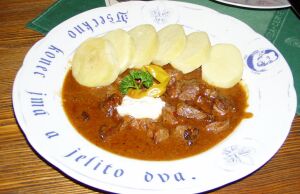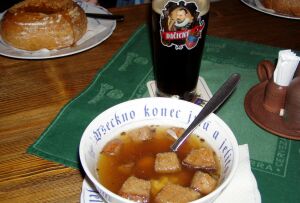Basic facts:
Czech food usually stands for large meals, almost drowning in sauce. Mostly very tasty sauce. Compared to other countries, there is usually a lack of Zelenina (vegetables) but plenty of meat. Naturally, many dishes from neighbouring countries can be found on the table as well, for instance Guláš (goulash) imported from →Hungary. Recently, a new dish became quite common in restaurants, called Hemenex. Guess what this is! Exactly, it's nothing more than 'ham & eggs'!
As in many other East European countries, menus contain not just the price of the dish, but also the weight in gramm: Pork/dumplings 150/100 and so on. This habit might derive from times where food rationing was necessary. However, it's quite useful since it makes it easy to understand beforehand what the guest is going to face soon. Dishes involving fish are an exception - the price is usually given in Crowns per gramm or 10 gramm. So if you wonder why the fried trout is so cheap, better look twice - at the end it might get very expensive.
Starter:
A Czech meal isn't complete without a starter. Among them, tasty Tresčí játra (cod liver) or the omnipresent Česneková polévka (garlic soup) are quite popular and highly recommended. As for the garlic soup, consumption should be limited to non-opera and non-clubbing days. In good restaurants, the soup comes with croutons and grated cheese to be put in the soup at the table. Assorted cheese cold cuts and ham rolls are quite common as well.
Main:
As mentioned above, there's not much vegetable with the main dish - it's usually limited to some raw vegetables cut into fine pieces. The main part consists of meat and loads of sauce. The meat is usually cooked, fried or - most commonly - breaded. Pork, beef, duck, chicken or game such as brawn (wild boar), venison and hare are very common. Especially game is excellent and shouldn't be missed.
Vegetarians will have a hard life in the Czech republic unless they stick to less traditonal, modern places - meatless food is usually limited to Smažený sýr (breadcrumbed cheese), which can be also recommended to carnivorous travellers, because it's really tasty. The hot, runny cheese is best served with Tatarska omáčka (Tatar sauce), some sort of mayonnaise with herbs, which needs to be ordered separately.
Because of obvious reasons, fish doesn't belong to the traditional Bohemian cuisine. At least no salt water fish. But thanks to the countless reservoirs and a few lakes there's plenty of fresh water fish. Especially in areas around reservoirs, dishes like Pstruh smažený (breaded trout) are quite popular. Nevertheless, fish is not a highlight of Bohemian cuisine.

| ||
| Czech style beef stew and potato dumplings |
Dessert:
One of the most typical desserts is Palačinka (Crepe). These thin pancakes come in several variations involving fruits, chocolate sauces and so on. Almost every restaurant offers a dessert called 'Palačinka surprise' (sic), but the 'surprise' is always the same - that is...no, I won't tell, it wouldn't be a surprise anymore.
Side dish:
Bohemia is highly famous for its Knedlíky (dumplings). They can be found everywhere. Usually there are two types - definitely No. 1 are the Houskové knedlíky (bread dumplings). These are large, yellowish-white and porous slices without much taste. However, they can absorb unbelievable amounts of sauce. Hence the dominance of sauces in Czech dishes. Less common but much tastier are the smaller Bramborové knedlíky (potato dumplings). But be warned - just a few slices and you will be stuffed.
Other popular side dishes include fried potatoes, small potato balls called croquettes, potato fritters, chips, rice and so on. There's a sweet version of dumplings, called Ovocné knedlíky (fruits dumpling), sometimes containing a whole plum. Very delicious!
Prices:
Basically, there are two categories: Prague and Non-Prague. Prices in moderate restaurants in the centre of Prague are still slightly lower as in Germany or Austria, but much more expensive then in places outside the capital. In less popular, smaller cities it's not unusual to get a complete meal incl. starters etc. for as less as 100 bis 150 Kč (€ 3 - 5). This would include meat. If you stick to crumbed cheese, which is quite filling as well, you won't pay more than around 60 Kč (€ 2). Outside the capital, half a liter of draught beer is between 10 and 14 Kč. In touristy places, esp. in Prague, you will often have to pay the double price.
Attention: In traditional pubs and other eateries, it's common to put together your own meal. Side dishes, sauces etc. must be ordered separately. Complete meals are usually only offered in touristy places along the Austrian and German border and in upmarket restaurants.
Beware!!! Especially in Prague, some black sheeps have different menus in their restaurants - with higher prices in the English or German version. What to do: If you think it's overpriced, ask for the Czech menu. Which might be complicated. Even better - just walk out, don't let them rip you off. Of course, there are also high-class restaurants with appropriate prices. But this can be seen from outside already. Use common sense.

| ||
| A classic: Garlic soup and dark beer |
Where to eat
Needless to say that self-catering is the cheapest way to get around. Just go to supermarkets like Tesco or Prior, grab some bread rolls or croissants, sausages and some of the delicious cheese, not to forget fruits etc. You won't be disappointed and only pay a few crowns if you stick to Czech products.
Fast Food is omnipresent in all bigger cities, especially in and around train stations. Fast food includes the typical stuff such as Hot Dogs, Hamburgers, Sandwiches etc. Quite cheap, but sure enough no gourmet stuff.
Occasionally you will come cross Bufet (also called Jídelna) - very cheap canteen-like eateries, but quality is usually poor. Only recommended to the hasty traveller.
The best way to eat out at night are Pivnice (also Hospoda, beer pubs) or Vinárna (wine pubs). Genuine atmosphere and plain but usually delicious food awaits the challenger. A beer or two or some wine will round up the meal. It's not a must to eat something - you might sit there for hours and hours and just enjoy a couple of drinks. Outside Prague, these places are the cheapest and most interesting places to go out. The more locals, the better the atmosphere. Try to avoid places only foreigners gather! Unfortunately, it's hard to find good pivnice in the centre of Prague.
Last but not least restaurants. Some of them are really called Restaurant. These places are usually more expensive, but not necessarily better in terms of quality. Most of the restaurants are called Restaurace. Alcoholic drinks are sold in all of them.
Pivo (beer):

| ||
| Not undrinkable: Velvet |
Guess who's #1 in per capita beer consumption in the world! For a long time, it was Germany. But Germany had lost the title, and so it's the Czech republic. What does this mean? Do Germans drink less beer? Or did Czechs increase their beer consumption? When you go to places near the German border, you will find countless Germans hanging around in pubs and restaurants. I presume that if all Germans would suddenly stop going to Czech, they would get back the title. The reasons for the beer-tourism are quite obvious. Czech is the home of beer and still produces excellent beers. Not to mention the price - half a liter of draught beer is around €3 in German bars but € 0.5 in Czech bars.
As in Germany, there is something like a beer culture. Countless breweries, many of them only known to locals, produce several types of beer. Worldwide famous is Budvar (Budweiser) from →České Budějovice (Budweis). The label is red and white, the beer itself is rather mild. I have no idea why this fine brewery gave away its good name to Anheuser-Busch in the States. The American version contains rice, corn and sugar and is simply an insult to the beer lover's palate.
Also quite famous is the Pilsner Urquell, which is drier then Budweiser. It can be found everywhere in the Czech republic and also in many other countries. By the way - both types are quite expensive in the Czech republic. It's always a good idea to have a Czech Budweiser or Urquell outside the Czech republic for the sake of the good taste, but better stick to local beers when you are in the Czech Republic - they are much cheaper and not seldomly even better.
Much more common in Czech restaurants and pubs is beer from breweries like Staropramen, Gambrinus, Krusovice and Radegast just to name but a few. Most beers come in different variations - most common are the 10º and 12º versions. Typical dialogue between ignorant visitors - 'Oh my god, this beer's got 12% alcohol'...'That's a bit strong, isn't it'. It isn't. The number refers to the brewery method and the hop share. Most beer lovers, including the author of these pages, prefer the more full-bodied 12º version. The Czech republic is mostly famous for Pilsner (lager) - style beer. However, some breweries, especially Staropramen, produce new and other types of beer as well. One result of Staropramen's experiments is called Velvet: A smooth, reddish stout with an interesting taste. Unfortunately, Velvet is not exported. Guess they drink it all by themselves. Velvet is comparatively expensive but worth a try.
Alcoholic content of Czech beers is usually quite low and mostly between 3.6 and 4 %. Besides lager types, dark beer (Cerny) is very common as well. Among others, Staropramen's dark beer and Kozel dark beer is quite popular.
Other drinks:
The Czech republic also produces quite drinkable white wine (bílé víno) - most of Liechtenstein's famous wine is actually produced in the Czech republic. Strong liqours definitely belong to Czech drinking culture. Very famous is Becherovka from →Karlovy Vary. This is a yellowish, quite sweet herb liquor with a distinctive taste. I have no idea why so many people like that stuff. Another popular herb liquor is called Fernet Stock. Almost undrinkable when pure, it can be very tasty when mixed with tonic. Just ask for 'Bavarian Beer'. Fernet stock comes in two more versions - lemon (citrus) and orange. The latter is highly recommended! The same distillery produces a malt whisky, called Printer's.It's taste: well, different. There are countless more fire waters, half of them produced by Stock. By the way, 'single' usually means 5 cl (in many other European countries 2 cl!).
©2024 Europe-East.com

 Albania
Albania Czech Republic
Czech Republic